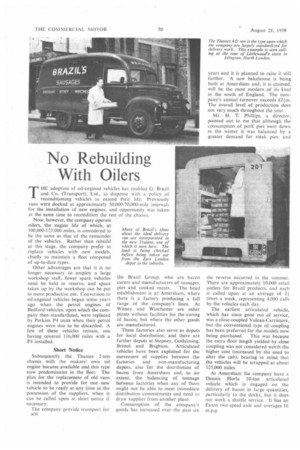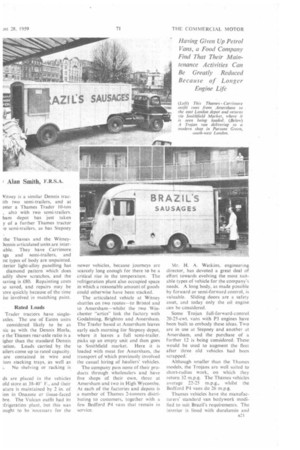No Rebuilding With Oilers
Page 54

Page 55

Page 56

If you've noticed an error in this article please click here to report it so we can fix it.
r Alan Smith, F.R.S.A.
THE adoption of oil-engined vehicles has enabled G. Brazil and Co. (Transport), Ltd., to dispense with a policy of reconditioning vehicles to extend their life. Previously vans were docked at approximately 50,000-70,000-mile intervals for the installation of new engines, and opportunity was taken at the same time to recondition the rest of the chassis.
Now, however, the company operate oilers, the engine life of which, at 100,000-125,000 miles, is considered to be the same as that of the remainder of the vehicles. Rather than rebuild at this Stage, the company prefer to replace vehicles with new models, chiefly to maintain a fleet composed of up-to-date types.
Other advantages are that it is no longer necessary to employ a large workshop staff, fewer spare vehicles need be held in reserve, and space taken up by the workshop can be put to more productive use. Conversion to oil-engined vehicles began some years ago when the petrol engines of Bedford vehicles, upon which the company then standardized, were replaced by Perkins P4 units when their petrol engines were due to be discarded. A few of these vehicles remain, one having covered 116,000 miles with a P4 installed.
Short Notice
Subsequently the Thames 2-ton chassis with the makers' own oil engine became available and this type now predominates in the fleet. The plan for the replacement of old vans is intended to provide for one new vehicle to he ready at any time in the possession of the suppliers, when it can he called upon at short notice if necessary.
The company provide transport for a20
the Brazil Group, who are bacon curers and manufacturers of sausages. pies and cooked meats. The head establishment is ar Amersham, where there is a factory producing a full range of the company's lines. At Witney and Winchester are other plants without facilities for the curing of bacon, but where the other goods are manufactured.
These factories also serve as depots for local distribution, and there are further depots at Stepney, Godalming. Bristol and Brighton. Articulated vehicles have been exploited for the movement of supplies between the factories and non-manufacturing depots. also for the distribution of bacon from Amersham and, to an extent, the balancing of tonnage between factories when any of them might not be able to meet immediate distribution commitments and need to draw supplies from another plant.
Consumption of the company's goods has increased over the past six years and it is planned to raise it still further. A new bakehouse is being built at Amersham and, it is claimed, will be the most modern of its kind in the south of England. The company's annual turnover exceeds £24m. The overall level of production does not vary much throughout the year.
Mr. H. T. Phillips, a director, pointed out to me that although the consumption of pork pies went down in the winter it was balanced by a greater demand for steak pies, and the reverse occurred in the summer. There are approximately 10,000 retail outlets for Brazil products, and each is called upon at an average of 21 times a week, representing 4,000 calls by the vehicles each day.
The earliest articulated vehicle, which has since gone out of service, was a close-coupled Vulcan-Carrimore, but the conventional type of coupling has been preferred for the models now being purchased. This was because the extra floor length yielded by close coupling was not considered worth the higher cost (increased by the need to alter the cab), bearing in mind that the vehicles will be scrapped at about 125,000 miles.
At Amersham the company have a Dennis Horla 10-ton articulated vehicle which is engaged on the delivery of bacon in large quantities, particularly to the docks, but it does not work a shuttle service. It has an Eaton two-speed aide and averages 16 Vitney is a similar Dennis tracith two semi-trailers, and at ester a Thames Trader 10-ton also with two semi-trailers. ham depot has just taken y of a further Thames tractor ?co semi-trailers, as has Stepney the Thames and the Witney)ennis articulated units are interable. They have Carrim ore igs and semi-trailers. and ,.st types of body are unpainted. tterior light-alloy panelling has diamond pattern which does adily show scratches, and the saving is £80. Repainting costs ;o saved, and repairs may be tore quickly because of the time ise involved in matching paint.
Rated Loads Trader tractors have singleaxles. The use of Eaton units considered likely to be as lie as with the Dennis Horla, e the Thames rear-axle ratio is a igher than the standard Dennis :ation. Loads carried by the ailers come up to rated capacity. are contained in wire and iurn stacking trays, as well as No shelving or racking is ds are placed in the vehicles old store at 38-40 F., and their ature is maintained by 2 in. of on in Onazote or tissue-faced bre. The Vulcan outfit had its frigeration plant, but this was aught to be necessary for the newer vehicles, because journeys are scarcely long enough for there to be a critical rise in the temperature. The refrigeration plant also occupied space in which a reasonable amount of goods could otherwise have been stacked.
The articulated vehicle at Witney shuttles on two routes—to Bristol and to Amersham—whilst the two Winchester "artics" link the factory with Godalming, Brighton and Amersham. The Trader based at Amersham leaves early each morning for Stepney depot, where it leaves a full semi-trailer, picks up an empty unit and then goes to Smithfield market. Here it is loaded with meat for Amersham, the transport of which previously involved the casual hiring of hauliers' vehicles.
The company pass none of their products through wholesalers and have five shops of their own, three at Amersham and two in High Wycombe. At each of the factories and depots is a number of Thames 2-tonners distributing to customers, together with a few Bedford P4 vans that remain in service. Mr. H. A. Watkins, engineering director, has devoted a great deal of effort towards evolving the most suitable types of vehicle for the company's needs. A long body, as made possible by forward or semi-forward control, is valuable. Sliding doors are a safety asset, and today only the oil engine can be considered.
Some Trojan full-forward-control. 20-25-cwt. vans with P3 engines have been built to embody these ideas. Two are in use at Stepney and another at Amersham, and the purchase of a further 12 is being considered. These would be used to augment the fleet after three old vehicles had been scrapped.'
Although smaller than the Thames models, the Trojans are well suited to short-radius work, on which they return 32 m.p.g. The Thames vehicles average 22-25 m.p.g., whilst the Bedford P4 vans do 26 m.p.g.
Thames vehicles have the manufacturers' standard van bodywork modified to suit Brazil's requirements. The interior is lined with duralumin and insulated with glass-fibre, and the reardoor aperture is narrowed so that, when opened, the doors do not exceed the width of the vehicle.
At one time the company adapted their vans to provide a full-width rear well for ease of entry, but this was abandoned because it was found that the near-side corner, having a reduced ground clearance, was too susceptible to damage caused by striking high kerbs. Drivers can enter current vehicles by means of steps in the middle, the lowest being an outrigged steel frame.
Other vehicles include six Austin 5-cwt. vans, of which there is one at each base except Brighton. All final deliveries from Brighton are made by contract vehicles. The 5-cwt. vans are used by sales-promotion staff.
Loading starts at about 4 a.m., so that they are ready to begin deliveries between 6.30 a.m. and 7.30 a.m. The vehicles are nearly always filled to capacity with goods in trays, cartons and bags. Trays are not left at customers' premises, so that calls do not involve the collection of empties remaining from previous deliveries.
In a 10-hour day a van might make 30-80 calls and cover 35-45 miles on town work, and up to 80 miles in the country. Many routes involve fairly long runs from the depots to the actual areas of delivery. Thus, deliveries from Amersham to Reading entail about 20 miles' continuous running on the outward and return journeys to the town itself, in which a call is made about every mile, the overall distance covered being 70 miles. Three vehicles are kept as spares for the delivery section of the fleet.
The maintenance programme involves monthly checks made by Brazil's own staff or that of vehicle manufacturers' dealers. Normally about 2,000 miles elapse between each servicing. Importance is attached to thorough inspection. Brakes, for example, are checked at 16,000-mile intervals and the usual practice is to fit new shoes at 32,000 miles.
Otherwise, during the life of the vehicles the company reckon to replace only the usual items of tyres and batteries. Exide batteries are fitted as replacements and are found to be capable of giving a three-year life.
Dunlop and Firestone covers are chosen for replacements, but Michelin X tyres are being tested on four vehicles. Life of textile covers on delivery vehicles is normally 24,000 miles, but this distance has already been exceeded by the semi-metallics. Retreads are not considered worth while.
Paintwork is touched up and varnished when necessary, but the latest rigid vehicles are being finished in I.C.I. coach enamel which requires no varnish. Similarly, the use of gold leaf has been eschewed in favour of imitation gold paint to save time when renovating paintwork.
The nature of the work possibly explains the scheduling of top overhauls at the comparatively short intervals of 25,000-30,000 miles, with the possible fitting of new piston rings at twice this distance. This means that a 4D engine receives three or four top overhauls before it is considered worn out and the vehicle is scrapped. It is expected that the P3 engines of the Trojans will require to be similarly dealt with.
Accountancy for fleet operations embraces the recording of expenses. but costs are not analysed as closely as was the practice two years ago. Detailed analysis is not thought to be as valuable as it was when economics, rather than mechanical condition. determined the replacement of a vehicle.
Similarly, a safety bonus scheme for drivers has been discontinued. Awards were made on a points basis and. although a good deal of calculation was involved, the results were not wholly successful. Instead, all new drivers, after they have been selected by the sales department, are now• tested by the British School of Motoring, Ltd.




















































































































